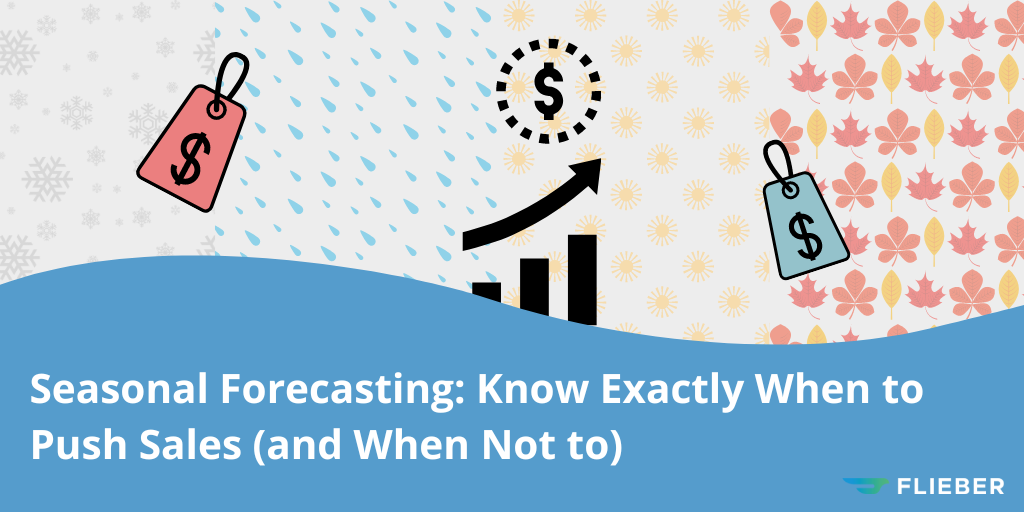As an e-commerce retailer, no two days are the same, especially when it comes to balancing your sales and inventory.
With peak season around the corner, do you push hard on sales and risk going out of stock? Or do you relax your sales activities and risk not selling enough?
Optimizing your inventory for seasonal variations takes focus, energy, and more manual work than you probably have time for. But failing to plan for seasonality could cost you even more.
In this article, we’ll explore simple steps to improve your seasonal forecasting, win back your time, and adjust your forecasting models for optimal sales year-round.
Table of contents
- Seasonal demand: Mastering the rhythm of your e-commerce business
- What is seasonal demand forecasting? The missing link in your inventory planning
- Master your seasonal inventory in 5 simple steps
- Make the most of your peak season with Flieber
Seasonal demand: Mastering the rhythm of your e-commerce business
The term seasonal demand refers to fluctuations in sales volume that generally repeat over a specified period of time. These ebbs and flows can occur across all or much of your inventory, or can affect only specific products.
For instance, in the US, demand for inflatable pools will increase in the months of May through August, and sales of ski goggles will see more traction in November through January. For the end of year holiday season, you can expect to see a jump in retail sales across most major categories.
Seasonal demand can be pegged to seasonal cycles such as the weather, holidays, or other annual occurrences like back-to-school shopping. It can also be tied to sales holidays and shopping events like Black Friday, Cyber Monday, and Prime Day.
Seasonal patterns will look different for each country, climate, or culture in which your business operates. Some seasonal purchases might be flipped in the southern hemisphere, or center around different holidays.
But seasonal demand isn’t just an annual trend. It can also refer to weekly or monthly occurrences.
For instance, you may find that your sales dip midweek, when consumers have less time off work to shop. Or they might increase on specific times or days of the month a majority of your customers receive their paychecks.
A solid understanding of seasonal demand is critical to your e-commerce success because it helps you be there when your customers need you most. Get it right, and you’re always prepared for a surge, without overspending when you don’t need to.
What is seasonal forecasting? The missing link in your inventory planning
Seasonal forecasting is a data-based approach to predicting fluctuations in seasonal demand. In seasonal demand forecasting, businesses analyze historical data going back several years (if possible), to see where peaks and valleys occur.
With this data, you can assess patterns in your sales cycle, so you know exactly when to take business-critical actions, such as adjusting your advertising spend and order quantities to meet future demand.
Seasonality is particularly important in inventory demand planning because it can help you:
- Avoid stockouts by ensuring you always have enough inventory in your reserves for important dates.
- Prevent over-ordering ahead of major events and reduce excess inventory costs.
- Schedule future orders at optimal times to increase working capital, instead of purchasing everything in bulk.
- Get ahead of potential supply chain issues around holidays, major shopping events, or other key trends by ordering earlier or diverting priority shipments to faster carriers.
- Increase your margins, sales, and ROI ahead of important events.
Effective seasonal forecasting helps you analyze trends over time and secure healthy margins year-round.
Seasonal forecasts can help keep your team effective in managing your day-to-day inventory and sales activities, while contributing to better strategic decisions. For example, an effective seasonal forecast can help you pinpoint the best time of year to launch a new product, or understand which offers and products to promote during peak season.
Whether you’re using moving averages or advanced seasonal indexes for exponential smoothing, finding and dissecting multiple data points across multiple spreadsheets often takes more time and bandwidth than you have. Let’s take a closer look at some simple ways to make your seasonal predictions more efficient.
Master your seasonal inventory in 5 simple steps
Understanding your seasonal inventory doesn’t have to be difficult, but there are some important steps to getting it right.
Here are five key ways to optimize your seasonal inventory for peak sales, without relying on bad data or complicated Excel macros.
1. Collect and clean your sales data
If you want an accurate forecast, you need accurate data.
But if you’re like most growing brands, you may be working from a cluttered tech stack with sales data in several different places, a messy system of inventory spreadsheets, or a combination of the two.
The first thing to do is aggregate all your sales and inventory data in one place.
Once you’ve got everything together, it’s time to clear and preprocess your data to get the best possible results.
Follow these steps to make sure you’re feeding your seasonal forecast with clean data:
- Remove duplicates, errors, and other inconsistencies.
- Add missing data, like sales on another platform or contained in a legacy system.
- Remove low sales figures due to a previous stockout or low in stock product. Replace with the average sales you would have sold if inventory had been available.
- Remove false signals (e.g., sales outliers, market and pricing anomalies, etc.)
This first step takes time, but it’s not one you want to skip. The good news is there are many demand planning systems that can automate much of this work for you.
For example, Flieber integrates with your sales channels, then automatically identifies irregularities, removes duplicates, and flags potential errors for you.
.png?width=599&height=245&name=Brand%20Graphics%20-%20Integrations%20(1).png)
2. Investigate outliers in your inventory
If you’re an active Amazon Prime Day participant, you already know that not all seasonal shopping events occur at the exact same time every year.
Let’s take a classic example:
Black Friday is always the Friday after Thanksgiving, but that doesn’t mean it always lands on the same date. If you're looking at your sales history for the past two years, make sure you’re not planning for two November sales spikes. Your seasonal forecast should be able to connect those seasonal dates and automatically attribute them to the same shopping event, in this case, Black Friday.
Of course, there could be other anomalies that impact your sales, like an unexpected weather event, labor dispute, or viral trend.
For example, let’s say you’re a textiles brand and you notice you’re selling high volumes of wool and plaid fabrics in August.
You thought your customers were just being super-prepared for winter. Every year, you plan accordingly, ordering extra stock and pushing sales. Then one summer, the new season of Outlander premieres two months early, and you sell out in June. Turns out your sales aren’t actually pegged to time of year as much as they’re aligned to the “Outlander Effect''. (In other words, everyone wants a Scottish stud costume so they can look like Jamie Fraser.)
In every niche and category, outliers can have a huge impact on the quality of your inventory data, which has an equally large knock-on effect on customer satisfaction. A strong seasonal forecasting system will help you track and adjust for changes in demand so that they don’t fall through the cracks in your spreadsheets.
3. Use your forecasts to put the pieces together
Today there are plenty of fancy AI-driven forecasting platforms on the market. But the real driver of successful seasonal forecasting is much simpler.
It’s about visibility.
With clean sales and inventory data in one place, it instantly becomes easier to start putting the pieces together.
To start, take a good look at your past sales and any other key recommendations your demand forecast provides.
Then, adjust for seasonal variations using the following action steps where relevant:
- Plan your sales and marketing activities. For example, if January is a low season for your products, you could plan extra promotions to entice shoppers and clear old stock.
- Adjust your replenishment dates so you don’t under- or overbuy. You can also reserve funds to purchase additional stock for peak seasons.
- Set individual reordering thresholds. While ordering in bulk can lead to discounts, buying out of season can also result in hefty storage fees. For optimal cost savings, use seasonal demand forecasting to set separate thresholds for seasonal versus foundational inventory.
Your inventory planning system should give you the ability to adjust your forecasts and get relevant recommendations based on your own lead times, sales patterns, and inventory levels.
Look for a customizable inventory planning platform that does what you need it to do. With Flieber, you can simply add the products you need, load the Forecast page, and get a single source of truth for your seasonal forecast.
4. Stay on top of your safety stock
Regardless of the season you’re in, sudden surges and drops can happen.
To avoid stockouts, you need to have some buffer stock available. But there’s a fine line between safety stock and excess inventory.
To decide how much safety stock you need, you could:
- Go with the 2-4 week method. Some experts recommend simply having 2-4 weeks’ worth of extra inventory for each product. But even 2-4 weeks could look very different in terms of financial impact, depending on your product and seasonality.
- Use a formula. Brands use several different formulas to calculate how much safety stock to have on hand, but most rely on a mix of data, including: past sales data, daily sales, seasonality, and order lead time.
- Try an AI forecast model. If you’re using an inventory planning system that includes AI, you can ask it how much buffer inventory you need when making recommendations about what and when to reorder.
Each method has its advantages and disadvantages, and there’s always some risk of overspending on warehouse space.
Aim to be as prepared as possible for a sudden increase in demand, without storing so much product that storage costs start eating into your bottom line.
5. Keep up with trends and watch out for surprises
With effective seasonal forecasting, you’ll develop a solid understanding of your brand’s seasonal ebbs and flows, no matter how unusual.
But even the most accurate forecasts can’t predict all the potential influences that could impact your inventory.
From El Niño to TikTok, there will always be news, trends, and even natural disasters that can pop up unexpectedly and derail your forecasts. For example:
- An influencer goes viral for calling out pickpockets, and your anti-theft bags see a huge increase in summer sales.
- A high-profile competitor gets a ton of sudden media flack for greenwashing, and its customers suddenly turn to more transparent, eco-friendly brands like yours.
- Wildfires in Canada ruin the air quality in New York City, prompting loads of sudden orders for facemasks you’d barely been able to move since 2021.
To stay ahead of the curve, set aside time to keep up with global events and the latest news that could impact your products, niche, and competitors.
You can also track customer sentiment by using social listening tools or setting up Google alerts to be notified anytime your brand is mentioned online.
Make the most of your peak season with Flieber
You could take all or most of these steps by hand, but with huge advances in automation, there’s no reason to keep doing these calculations manually.
With Flieber’s seasonal forecasts, you can:
- See your sales and inventory history under one roof, bringing together data from all your spreadsheets and sales channels in one easy-to-use dashboard.
- Get custom SKU-level recommendations for exactly what, when, and how much to re-order.
- Automate manual tasks like reordering to make more time for strategic projects.
- Make better inventory decisions in a fraction of the time.
Gain full control over your inventory. Flieber automates your forecasting, runs advanced scenarios to help you plan, and sends real-time alerts when it’s time to take action.
See for yourself with a free personalized demo today!



-1.png)

